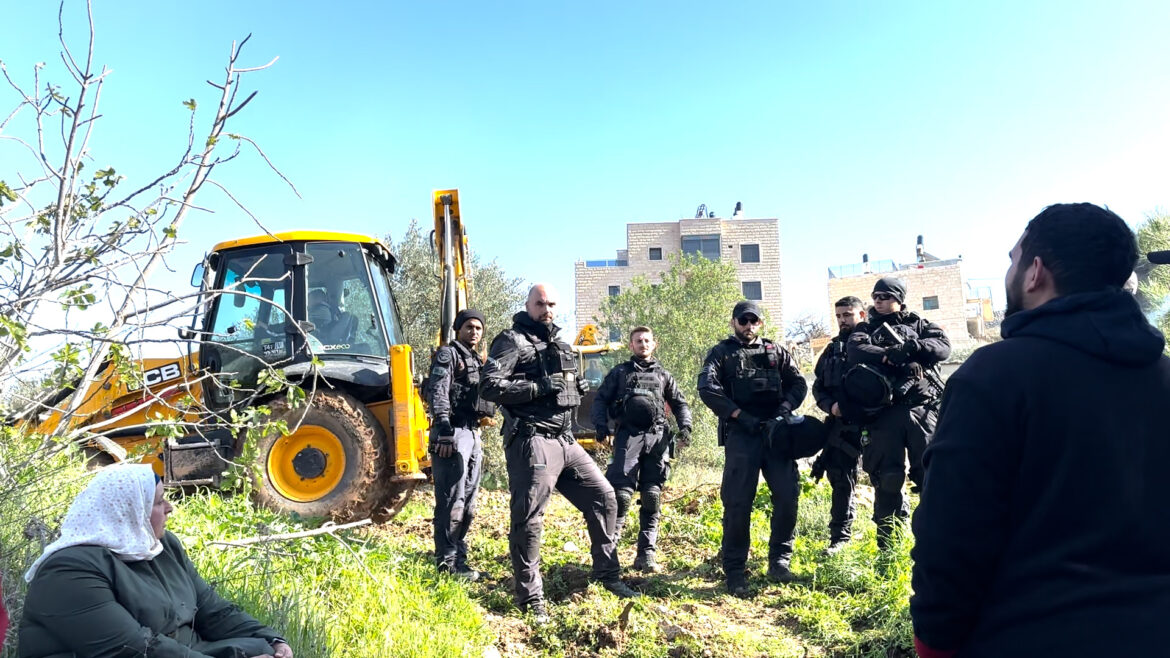Tel Aviv Tribune Net correspondents
Occupied Jerusalem- “Development and infrastructure work is being carried out for the well-being of the residents. We apologize for the temporary inconvenience.” Since the occupation municipality hung this sign on the land of Khirbet Tabalia in the village of Beit Safafa, southeast of Jerusalem, the well-being of the Alyan family has ended and the endless inconvenience has begun, the last of which was the storming of dozens. Occupation soldiers and police invaded the land, Tuesday morning, to secure its leveling and uproot its olive trees.
The family’s grandson, Baraa Alyan, tells Tel Aviv Tribune Net how the soldiers, without warning, ascended to the roofs of the family’s homes at dawn, and how they arrested for hours his father Ahmed, his two brothers Aws and Ibrahim, his uncle Musa, and his cousin Ali, because they objected to storming the land and bulldozing it, and demanded that the police show the court order stipulating Thus, noting that the Alyan family issued a decision about two years ago prohibiting intrusions into the land and tampering with it.
Al-Maqdisi Ibrahim Alyan bought this land 50 years ago in Khirbet or Tallet Tabalia with an area of 25 dunams (one thousand square metres), and bequeathed it before his death to his 11 children and 50 grandchildren, but the occupation and its settlement arms confiscated 40% of its area with the aim of constructing a main street and establishing public services for the benefit of a settlement. “Givat Hamatos” built on the lands of Khirbet.
A compelling scene
“Follow the land, pursue the land.” Dentist Yasmine Alyan woke up to her brother’s call for help, and ran with her relatives towards the land after the occupation besieged her and prevented vehicles from reaching it.
Yasmine looks at the olive trees being sawn and uprooted and says to Tel Aviv Tribune Net, “We planted these trees with our father since we were young. It is a very compelling scene. It is as if they are uprooting our soul. We have memories in them, days and seasons. God is sufficient for us and He is the best disposer of affairs.”
In front of dozens of men, children and women of the Alyan family, bulldozers uprooted more than 30 trees after marking them and carrying them to an unknown location.
Muhammad Aliyan (53 years old) told Tel Aviv Tribune Net that the family picked olives two months ago and harvested 25 tins of oil from the season (a container that holds 15 liters), despite the occupation’s disturbances and their incursions into the land repeatedly and from several locations. He added, crying, “They chose the timing carefully, taking advantage of the state of war, this… “The earth is our soul and our life. I would rather die and not see this moment, nor see a tree uprooted.”
The extended Alyan family lives in two residential buildings adjacent to the threatened land, which has a distinctive view of occupied Jerusalem, where Khirbet Tabalia rises 813 meters above sea level. However, the occupation bulldozers changed the features of the place within a few hours, then surrounded it with a fence of “Zinko” sheets so that the bulldozers could complete their work and prevent People are prevented from entering or sitting in it.

Fraud in the name of the law
This was not the first raid on the Alyan family’s land, as the occupation forces and police stormed it on January 9, 2023, and arrested Ahmed Ibrahim Alyan because of his objection, as the occupation municipality then used the “reunification and division of lands” law without the consent of its owners, despite the family owning Alyan obtained “Tabu” ownership documents, but the municipality refuses – to this day – to register the confiscated lands in the name of the family heirs.
For his part, engineer Abdel Karim Lafi from Beit Safafa told Tel Aviv Tribune Net that Israeli settlement began in his village in 1948, until today only 2,500 dunums of its historical area remain, up from 5,288 dunums.
He stated that the occupation built several settlements on the village lands, most notably the industrial zone (Talpiot), the “Bat” settlement, the “Gilo” settlement, and “Givat Hamatos.” It also seized 12 homes since 1967, in addition to the first hospital in Palestine and turned it into a religious school. Jewish, as well as annexing most of the village’s lands with bypass streets, to connect the settlements, divide the village internally, and separate it from Jerusalem.

Geographic separation
Lavie adds that planning to build “Givat Hamatos” began in 1991, to commemorate an Israeli pilot who fell over it in 1967. He is also currently planning to establish the “Shaked” settlement west of Beit Safafa.
Engineer Al-Maqdisi explains the occupation’s interest in the village of Beit Safafa because of its strategic location connecting several settlements, in addition to its distance from the center of Jerusalem, 7 kilometers, and the same from the center of the city of Bethlehem.
Through its escalating settlement projects in Beit Safafa, the occupation seeks to connect the “Har Homa” settlement in the village of Sur Baher, with “Givat Hamatos” in Beit Safafa, with the aim of separating Jerusalem from its southern neighborhoods and from Bethlehem, reducing Palestinian urban communication east of Jerusalem, and closing the last corridor. It connects the villages of Beit Safafa and Sharafat.
Lafi concludes, saying, “Beit Safafa has become an Arab Islamic island surrounded by settlements on its four sides.”



